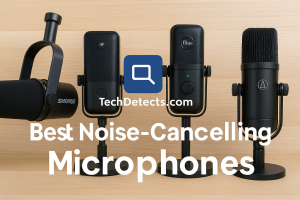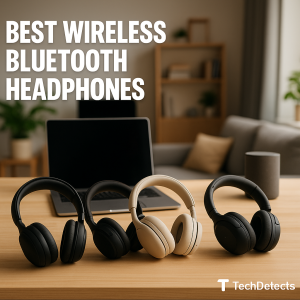Best Noise-Cancelling Microphones (2025 Edition)
Whether you’re a podcaster, streamer, remote worker, or field recorder, background noise can ruin the clarity of your voice. Noise-cancelling microphones are designed to block out ambient distractions and focus on your voice — using directional pickup patterns, built-in DSP, or smart software integration.

In this guide, we’ve selected the best noise-cancelling microphones in 2025 based on real-world voice clarity, noise isolation, Amazon availability, and overall value.
List of Best Noise-Cancelling Microphones
Shure MV7+ (USB/XLR Dynamic Microphone)
Specs: Hybrid USB-C & XLR, built-in DSP, cardioid pattern, touch panel controls
Short Review:
The MV7+ is one of the most versatile and polished podcast mics out there. It offers automatic level control, tone shaping, and excellent off-axis rejection. The combination of USB and XLR makes it future-proof and beginner-friendly.
Pros: Superb vocal clarity, dual connectivity, voice isolation
Cons: Needs software for full features
Best For: Podcasters, streamers, creators upgrading from basic USB mics
Elgato Wave:3 (USB Condenser Microphone)
Specs: USB-C, cardioid pickup, Clipguard tech, Wave Link mixing software
Short Review:
The Wave:3 is an all-in-one mic and digital mixer combo. Elgato’s Clipguard prevents peaking, and the mic includes subtle background suppression via software EQ. It’s great for streamers or YouTubers using OBS.
Pros: Software-driven noise handling, good vocal presence, easy setup
Cons: No XLR option
Best For: Streamers, remote meetings, solo content creators
RØDE PodMic (XLR Dynamic Microphone)
Specs: XLR, dynamic capsule, cardioid pattern, internal pop filter
Short Review:
This affordable dynamic mic blocks out room noise naturally thanks to its tight pickup pattern and robust build. It’s ideal when paired with an audio interface, and great for vocal-heavy content.
Pros: Budget-friendly, clear voice, rugged
Cons: Needs an interface or USB converter
Best For: New podcasters, home studios on a budget
Blue Yeti X (USB Condenser Microphone)
Specs: USB, multiple patterns (cardioid, omni, etc.), onboard gain and LED metering
Short Review:
This updated Yeti adds DSP and better clarity while maintaining the flexibility of multi-pattern pickup. It’s a great all-purpose mic with voice filters and some ambient noise shaping.
Pros: Multiple pickup options, intuitive controls
Cons: Bulkier design
Best For: Voiceovers, interviews, conference calls
Audio-Technica AT2050 (Multi-Pattern XLR Condenser)
Specs: XLR, cardioid/omni/figure-8, low-cut filter, 80Hz switch
Short Review:
The AT2050 provides great flexibility with its switchable patterns and delivers rich tone with low self-noise. Use it in a treated space and you’ll get studio-grade sound with minimal interference.
Pros: Studio-grade clarity, switchable patterns
Cons: Needs interface, not ideal for untreated rooms
Best For: Music and voice studios, advanced creators
Sennheiser MKE 400 (Compact Shotgun Mic)
Specs: 3.5mm TRS/TRRS, internal windscreen, shock mounting, battery-powered
Short Review:
This directional shotgun mic cuts through ambient noise in outdoor and indoor setups. Built for mirrorless cameras, it’s great for creators needing clean voice pickup in mixed environments.
Pros: Directional focus, travel-friendly, reliable brand
Cons: Not suited for USB workflows
Best For: Vloggers, mobile content creation, camera setups
Sony ECM-AW4 (Wireless Lavalier Microphone Kit)
Specs: Wireless digital transmission, lav mic + clip-on transmitter, 150ft range
Short Review:
Sony’s wireless kit performs well for on-the-go recording, delivering good voice capture with background noise reduction. It’s a great companion for interviews, tutorials, or mobile shoots.
Pros: Wireless freedom, plug-and-play, surprisingly clear
Cons: Basic mic quality compared to studio gear
Best For: Interviews, instructors, field reporters
📊 Comparison Table
| Microphone | Type | Connectivity | Best For |
|---|---|---|---|
| Shure MV7+ | Dynamic | USB/XLR | Podcasters, hybrid creators |
| Elgato Wave:3 | Condenser | USB | Streamers, remote workers |
| RØDE PodMic | Dynamic | XLR | New podcasters, small studios |
| Blue Yeti X | Condenser | USB | General voice work, interviews |
| AT2050 | Multi-pattern | XLR | Studio recording, advanced users |
| Sennheiser MKE 400 | Shotgun (camera) | 3.5mm | On-the-go creators, vloggers |
| Sony ECM-AW4 | Lavalier (wireless) | Wireless | Field interviews, tutorials |
🏁 Final Verdict
If you want the best blend of simplicity and clarity, the Shure MV7+ delivers high-end results in any setup. For USB users, the Elgato Wave:3 is great with noise-handling software. Need a budget option? Try the RØDE PodMic. For field and video creators, Sennheiser MKE 400 and Sony ECM-AW4 bring reliability outdoors.
❓ FAQ
Q: What makes a mic noise-cancelling?
Either directional design (like cardioid or shotgun mics), built-in DSP, or software filtering can reduce ambient noise effectively.
Q: Is a dynamic or condenser mic better?
Dynamic mics are better in noisy rooms. Condenser mics offer clarity but need treated environments.
Q: Can USB mics compete with XLR?
Yes. High-end USB mics like the MV7+ or Yeti X offer DSP features that rival studio setups.
Q: Do I need an audio interface?
Only for XLR mics. USB mics plug directly into computers.
Q: Best mic under $100?
The RØDE PodMic and Elgato Wave:1 (not listed) are strong sub-$100 choices.





